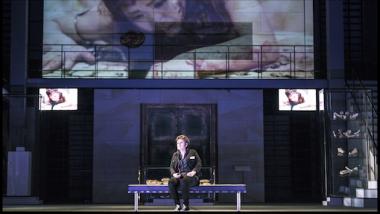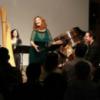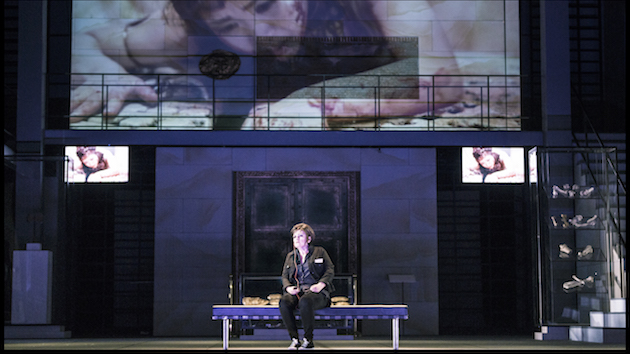
Elektra Conductor’s “Richard Strauss Year”
Show of hands please: Who is familiar with Richard Strauss’s Macbeth? Just as I thought, I am not alone in saying “Strauss’s what?” Even Henrik Nánási, who will conduct the composer’s early and seldom-performed symphonic poem in Europe, admits that it’s a rarity: “You never hear it.”
The Hungarian-born Berlin resident is making his San Francisco Opera debut next month, leading Strauss’s Elektra, in a co-production with Prague and Karlsruhe. Nánási is amused — and pleased — by the coincidental convergence with the composer, “being a Strauss guy,” he told SFCV. “After Elektra here, I will conduct Macbeth and Till Eulenspiegel in Essen, Also sprach Zarathustra in Tokyo, Ein Heldenleben in Atlanta, then Salome in the Royal Opera in London.”
When a conductor first leads a work, his or her preparation begins a long time before. For Nánási, that beginning more than a year ago was memorable:
“When I first started studying the score for Elektra, I was planning to spend a couple of hours with it on the first day, and 10 hours later, I realized you cannot stop. It sucks you in.”
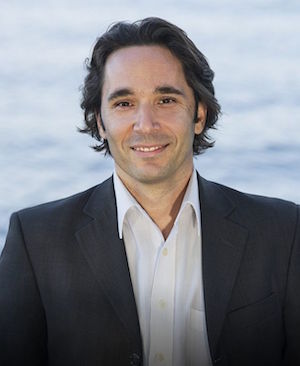
As is the case for just about everybody, Nánási’s first response to the music was somewhat of a shock: “On first hearing, it’s loud, violent, ugly.” But then comes the wash of lyrical passages, “So much deeper,” Nánási muses, “this pain of everybody — not just Elektra — how they cope with the past, for me it’s the story of a family, that comes first for me, not all the blood and tragedy. What appealed to me was Elektra the person gave up everything for one thing ...”
That thing, of course, is revenge of her mother’s murder of her father, Agamemnon — after which she inevitably dies in the opera, unlike in Greek mythology, which has her marry Pylades and live not entirely happily ever after.
Nánási was born in Pécs, Hungary, in 1975. After studying piano and composition at the Béla Bartók Conservatory in Budapest he continued his studies in Vienna, and later worked as a musical assistant at the Royal Opera House Covent Garden under Antonio Pappano. He became first conductor at the Staatstheater am Gaertnerplatz in Munich. From 2012 until earlier this year, Nánási served as general music director of Komische Oper Berlin.
Looking in the Opera Archives, SFO Senior Communications Manager Jeffery McMillan discovered that Nánási continues a distinguished Hungarian-Elektra connection in the War Memorial: The first two productions here were both led by Hungarians: Fritz Reiner (1938-39) and Georg Solti (1953-54), and it was Solti’s U.S. debut. The first Elektra, in 1938, was a Hungarian soprano: Rose Pauly.
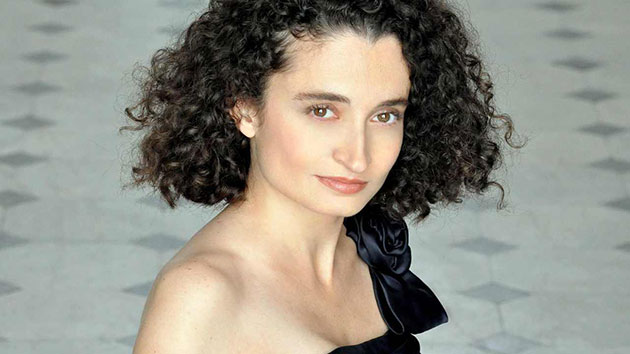
Ars Minerva Revivifies 1665 La Circe
Ars Minerva, Céline Ricci’s San Francisco company dedicated to “bringing back to life forgotten music,” has already presented Daniele da Castrovillari’s 1662 La Cleopatra and Carlo Pallavicino’s 1679 The Amazons in the Fortunate Isles.
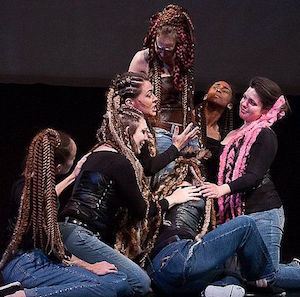
The organization’s credo is that “Recreating operas is a rare and captivating experience we are happy to share with the diverse community of the region.” On tap now: Sept. 8 and 9 in the ODC Theater, Pietro Andrea Ziani’s La Circe. Ricci, who directs the show, says this will be the first performance of the opera since its creation in 1665.
The La Circe manuscript, found in the Biblioteca Marciana in Venice, is attributed to Ziani (1616–1684), with a libretto by Cristoforo Ivanovich. Ziani was the organist at St. Mark’s Basilica in Venice and served the Holy Roman Empress, Eleonor Magdalene of Neuburg, in Vienna later in his life. Ivanovich was the first historian of Venetian opera and was a librettist for several operas performed in Venice, Vienna, and Piacenza. He catalogued all opera performances held in Venice from 1637 until 1681 in his treatise Memorie teatrali di Venezia, published in 1680 as part of the collection Minerva al tavolino.
La Circe is inspired by the adventures of Circe, the goddess and magician of Greek mythology made famous in Homer’s Odyssey and in Ovid’s Metamorphosis. After Ulysses escapes Circe’s clutches, the outraged enchantress remains on her island with a number of unlucky captives who fall victim to her resentment and manipulations.
Ars Minerva is promising “Dreadful potions, transformations, dancing Graces, Furies, and other colorful agents of evil — alongside carnivalesque comic scenes — bring drama featuring laments, rage arias, and drinking tunes.”
Sung in Italian with English supertitles, the opera will be semistaged and will feature eight singers, an acrobat, and an orchestra led by Derek Tam. Circe is sung by Ricci, the cast includes Kindra Scharich, Aurélie Veruni, Jasmine Johnson, Kyle Stegall, Billy Sauerland, Jonathan Smucker, Igor Vieira, and acrobat Katherine Hutchinson.
In other activities, Ars Minerva has collaborated with several other Bay Area organizations such as Humanities West, Museum of Performance + Design, the Magnes Collection of Jewish Art and Life, and the Italian Cultural Institute of San Francisco. The organization also created Baroque for Kids, an outreach program for high school students with the Italian class of the Ruth Asawa School for the Arts.
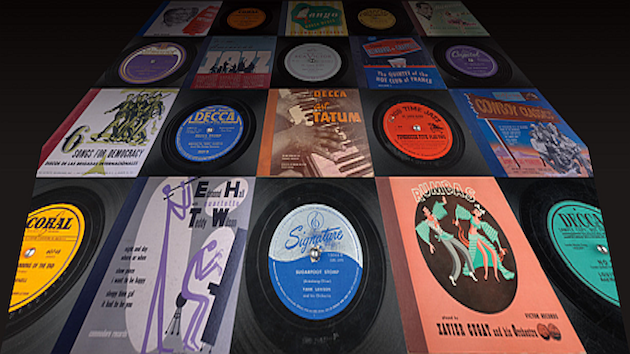
Classic 78 RPMs Saved, Processed, Made Available to the Public
Yes, you can spin classic 78 rpm discs online and free — 25,000 of them — one at a time. George Blood Audio LP, an audio preservation company, has been saving some of America’s musical heritage that otherwise was certain to disappear otherwise, and is making available to one and all.
This is just the first batch of an estimated 400,000-piece virtual record collection to be made available by the Internet Archive, from gospel by the Tuskegee Institute Sings, to opera recorded in Italy, to novelty tunes by Spike Jones, to hot — though obscure — jazz.
The task of digitizing all of those old records is happening in Philadelphia’s Chestnut Hill neighborhood, in a little storefront building on Germantown Avenue.
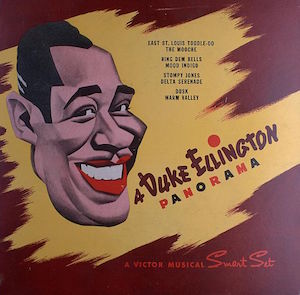
Here’s an example of how to use the site: From the project main page, if you select A Duke Ellington Panorama, there is complete information about the discs, including “Digitized at 78 revolutions per minute. Four stylii were used to transfer these records. They are 3.8mm truncated conical, 2.3mm truncated conical, 2.8mm truncated conical, 3.3mm truncated conical. These were recorded flat and then also equalized with Turnover: 250.0, Rolloff: -5.0.” Just in case you want to be fully informed.
Then download options range from 24-bit FLAC to VBR M3U, or just stream them cut by cut, for example “Delta Serenade.” And 24,999 to go. (Go also to the main Archive.org site for a wealth of musical offerings.)
From about 1898 to the 1950s, an estimated three million sides were made on 78 rpm discs. While many of the commercially viable recordings have been restored and remastered onto hard copies or digital files, there is still research value in the content of the rarer 78 rpm discs and recordings.
Already, over 20 collections have been selected by the Internet Archive for physical and digital preservation and access. Started by many volunteer collectors, these new collections have been selected, digitized and preserved by the Internet Archive, George Blood LP, and the Archive of Contemporary Music.

